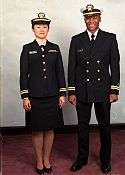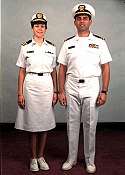United States Public Health Service Commissioned Corps
The United States Public Health Service Commissioned Corps (PHSCC),[10] also referred to as the Commissioned Corps of the United States Public Health Service,[11] is the federal uniformed service of the U.S. Public Health Service (PHS), and is one of the eight uniformed services of the United States. The commissioned corps' primary mission is to the protection, promotion, and advancement of health and safety of the general public.
| United States Public Health Service Commissioned Corps | |
|---|---|
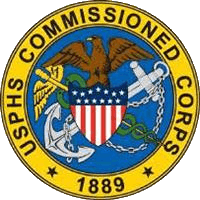 USPHS Commissioned Corps emblem fashioned after the Corps' official seal. | |
| Founded | 4 January 1889[1] |
| Country | |
| Type | Uniformed service |
| Role | Healthcare and medical services |
| Size | 6,000+ officers[2] |
| Part of | |
| Headquarters | Division of Commissioned Corps Personnel and Readiness, North Bethesda, Maryland, U.S. (Rockville mailing address) |
| Motto(s) | "Protecting, promoting and advancing the health and safety of the Nation!" and "In officio salutis"[3] (core values: Leadership, Service, Integrity, and Excellence) |
| Colors | Blue and Yellow-Gold [4][5][6] |
| March | "Public Health Service March"[7] |
| Anniversaries | Centennial, 1989 |
| Engagements | Spanish–American War[8] World War I[8] World War II[8] War in Afghanistan Iraq War |
| Decorations | |
| Commanders | |
| Assistant Secretary for Health | ADM Brett P. Giroir[9] |
| Surgeon General | VADM Jerome Adams |
| Principal Deputy Assistant Secretary for Health | RADM Sylvia Trent-Adams |
| Deputy Surgeon General | RADM Erica G. Schwartz |
| Notable commanders |
|
Along with the NOAA Commissioned Officer Corps, the Public Health Service Commissioned Corps is one of two uniformed services that consist only of commissioned officers and has no enlisted or warrant officer ranks, although warrant officers have been authorized for use within the service.[12] Officers of the commissioned corps are classified as noncombatants, unless directed to serve as part of the military by the President or detailed to a service branch of the military.[13] Members of the commissioned corps wear the same uniforms as the United States Navy, or the United States Coast Guard (when assigned to the Coast Guard), with special PHS Commissioned Corps insignia, and hold naval ranks equivalent to officers of the U.S. Navy and U.S. Coast Guard. Commissioned corps officers typically receive their commissions through the commissioned corps's direct commissioning program.
As with its parent division, the Public Health Service, the commissioned corps is under the direction of the United States Department of Health and Human Services. The commissioned corps is led by the Surgeon General, who holds the grade of vice admiral.[14] The Surgeon General reports directly to the Department of Health and Human Services, Assistant Secretary for Health; the Assistant Secretary of Health may be appointed to the rank of admiral if he or she is also a serving uniformed officer of the commissioned corps.[14]
History
The Public Health Service Commissioned Corps had its beginnings with the creation of the Marine Hospital Fund in 1798, which later was reorganized in 1871 as the Marine Hospital Service. The Marine Hospital Service was charged with the care and maintenance of merchant sailors, but as the country grew, so did the ever-expanding mission of the service. The Marine Hospital Service soon began taking on new expanding health roles that included such health initiatives that protected the commerce and health of America. One such role was quarantine.
John Maynard Woodworth, a famous surgeon of the Union Army who served under General William Tecumseh Sherman, was appointed in 1871 as the Supervising Surgeon. Woodworth's title was later changed to "Supervising Surgeon General," which later became the Surgeon General of the United States. Woodworth is credited with the formal creation of the Commissioned Corps. Woodworth organized the Marine Hospital Service medical personnel along Army military structure in 1889 to facilitate a mobile force of health professionals that could be moved for the needs of the service and country. He established appointment standards and designed the Marine Hospital Service herald of a fouled anchor and caduceus. Later that year of 1889, President Grover Cleveland signed an Act into law that formally established the modern Public Health Service Commissioned Corps (then the Marine Hospital Service under the Supervising Surgeon (later Surgeon General)). At first open only to physicians, over the course of the twentieth century, the Corps expanded to 11 careers in a wide range of specialties to include veterinarians, dentists, engineers, pharmacists, nurses, environmental health specialists, scientists, dietitians, and other allied health professionals.[15]
Today, the commissioned corps is under the United States Public Health Service (PHS), a major agency now of the U.S. Department of Health and Human Services (HHS), established by Congress in 1979-1980. It was previously established in 1953 as the U.S. Department of Health, Education and Welfare (HEW), and is still led by the Surgeon General. The commissioned corps allocates officers to all seven uniformed services depending on the health or medical needs of the other uniformed services.
By the 1980s, the wearing of uniforms on a day-to-day basis was not consistently practiced. In 1987, Surgeon General C. Everett Koop advocated for consistent use of the uniform while on duty, although he allowed individual agencies to determine their own requirements. in 2004, Surgeon General Richard Carmona, made uniforms compulsory whenever officers were on duty.[16]
The 2010 Patient Protection and Affordable Care Act established a Ready Reserve Corps for the PHSCC, but technical errors in the legislation prevented it from being implemented until the errors were corrected in the 2020 CARES Act.[17][18]
Purpose
The stated mission of the Commissioned Corps of the U.S. Public Health Service is "Protecting, promoting, and advancing the health and safety of the Nation" in accordance with the commissioned corps's four Core Values: Leadership, Excellence, Integrity, and Service. Officers execute the mission of the commissioned corps in the following ways:
- Help provide healthcare and related services to medically underserved populations: to American Indians, Alaska Natives, and to other population groups with special needs;
- Prevent and control disease, identify health hazards in the environment and help correct them, and promote healthy lifestyles for the nation's citizens;
- Improve the nation's mental health;
- Ensure that drugs and medical devices are safe and effective, food is safe and wholesome, cosmetics are harmless, and that electronic products do not expose users to dangerous amounts of radiation;
- Conduct and support biomedical, behavioral, and health services research, and communicate research results to health professionals and the public; and
- Work with other nations and international agencies on global health problems and their solutions.
As of 2019, the most common agency for Commissioned Corps officers was the Indian Health Service, followed by the Food and Drug Administration, and then the Centers for Disease Control and Prevention. The increased benefits and pay of Commissioned Corps officers is considered especially beneficial for the Indian Health Service, where recruitment is difficult due to the remote locations of many of its jobs.[19]
Plus, the commissioned corps provides officers (Medical Officers, Dental Officers, Therapists, Environmental Health Officers, etc.) to other uniformed services, primarily the United States Coast Guard and the National Oceanic and Atmospheric Administration Commissioned Officer Corps (NOAA Corps). Commissioned corps officers may be detailed to other federal agencies including the Department of Defense, TRICARE, Department of Justice (Federal Bureau of Prisons), State Department, Department of Homeland Security, and the Department of the Interior (National Park Service). Commissioned corps officers may develop individual memoranda of understanding (MOUs) with other organizations, including state and local health agencies, and even non-governmental organizations (NGOs).
The Commissioned Corps is often called upon by other federal, state, and local agencies to aid and augment in times when those agencies' resources are overwhelmed. These responses are designated as deployments by the commissioned corps, if the deployment is outside of the officer's "normal" duties, and coordinated through the commissioned corps's Readiness and Deployment Operations Group (REDDOG) in the Division of Commissioned Corps Personnel and Readiness (DCCPR).[20] Deployments may be for technical needs in standard settings, or in the event of disasters, in austere environments.
The commissioned corps may be militarized by the President. 42 U.S.C. § 217 states:
In time of war, or of emergency involving the national defense proclaimed by the President, he may by Executive order declare the commissioned corps of the Service to be a military service. Upon such declaration, and during the period of such war or such emergency or such part thereof as the President shall prescribe, the commissioned corps (a) shall constitute a branch of the land and naval forces of the United States, (b) shall, to the extent prescribed by regulations of the President, be subject to the Uniform Code of Military Justice, 10 U.S.C. § 801 et seq., and (c) shall continue to operate as part of the Service except to the extent that the President may direct as Commander in Chief.
Deployments
The commissioned corps is often deployed as part of the National Response Framework Emergency Support Function #8 – Public Health and Medical Services, but can be deployed outside of the Framework for various needs to other federal agencies, states, local governments, or even to aid foreign governments. Like all other federal-level responses, commissioned corps officers are deployed only upon request, and upon the recommendation of the Surgeon General and permission of the Assistant Secretary for Health. During deployments, commissioned corps officers may report to regular office spaces, such as coordinating responses at state-of-the-art emergency operations centers, or into the field in extremely austere environments, such as when responding to a natural disaster. In addition, deployments may either be on an individual basis, such as when specific skill sets are needed, or as part of a team, when large-scale responses are needed.
The commissioned corps uses a tiered system of response, with Tier 1 response teams ready and able to respond to an event within 12 hours, and Tier 2 teams ready and able to respond within 36 hours. Officers not on Tier 1 or 2 teams are Tier 3 responders, ready and able to respond to an event in 72 hours. Tier 1 teams are primarily made up of Rapid Deployment Force (RDF) teams that are made up of over 100 officers with multiple specialties, and are focused on providing acute clinical care of disaster-exacerbated chronic conditions. Officers who do not work as a clinical care provider on one of these teams are often in support roles, such as logistics, administration/finance, or planning. Tier 2 teams are composed of a smaller, more specialized workforce. Current Tier 2 teams include the Applied Public Health Team (APHT), the Mental Health Team (MHT), and the Services Access Team (SAT). Tier 3 commissioned corps officers not already assigned to one of the Tier 1 and Tier 2 teams are used to augment the Tier 1 and Tier 2 teams in the event of staffing shortages due to availability, or the need to scale up a response.
They are trained and equipped to respond to public health crises and national emergencies, such as natural disasters, disease outbreaks, or terrorist attacks. The teams are multidisciplinary and are capable of responding to domestic and international humanitarian missions. Some notable deployments involving the Public Health Service Commissioned Corps include:[21]
- 1989 – Hurricane Hugo; Loma Prieta, California, earthquake.
- 1992 – More than 1,000 PHS officers were deployed to South Dade County, Florida, following Hurricane Andrew.
- Early 1990s – Flooding throughout the United States and Alaska.
- 1994 – Northridge, California, earthquake.
- 1995 – Bombing of the Alfred P. Murrah Federal Building in Oklahoma City, Oklahoma.
- 1995 – Hundreds of PHS officers were deployed to the U.S. Virgin Islands following Hurricane Marilyn.
- 1999 – Hospital center at Fort Dix, New Jersey, for Kosovo Refugees
- 2001 – More than 1,000 PHS officers were deployed to New York City after the attacks on September 11, 2001 to aid victims and provide medical and mental health services to responders and rescue workers.
- 2001 – 2001 anthrax attacks
- 2004 – Hurricane Ivan.
- 2004 – 2004 Indian Ocean earthquake and tsunami
- 2005 – More than 2,000 PHS officers deployed to set up field hospitals and render aid and assistance to evacuees and responders in the wakes of Hurricane Katrina, Hurricane Rita, and Hurricane Wilma.[22]
- 2006 – 2006 Kiholo Bay earthquake[21]
- 2007 – Medicine Contamination in Panama
- 2008 – PHS-2 Rapid Deployment Force deployed pre-landfall to Louisiana in advance of Hurricane Gustav. It became the first standing PHS team to set up and run a Federal Medical Station. The team and 200 patients rode out the hurricane in Alexandria's Riverfront Center. RDF-1 and RDF-3 deployed pre-landfall in advance of Hurricane Ike to set up Federal Medical Stations in College Station, Texas, and Baton Rouge, Louisiana, respectively.
- 2008 – Hurricane Ike
- 2009 – 2009 Samoa earthquake and tsunami
- 2010 – Haiti earthquake; Deepwater Horizon oil spill in the Gulf of Mexico.
- 2011 – 2011 Japan tsunami and earthquake
- 2012 – Hurricane Sandy.[23]
- 2014 – 2014 American immigration crisis[24] of Unaccompanied Minor Children.
- 2014–2015 – Ebola outbreak response[25] including Ebola virus epidemic in Liberia—Ebola field hospital for health workers at Harbel near Monrovia[26]
- 2016–present – Great Plains region of the Indian Health Service.
- 2017–present – Hurricane Maria, Hurricane Irma, and Hurricane Harvey
- 2019-present - COVID-19 pandemic
In addition to disaster response, the commissioned corps frequently partners with the United States Navy on their health diplomacy missions. PHS Corps officers have been part of the Navy's Pacific Partnership (in the Pacific basin) and Continuing Promise (in the Caribbean/west Atlantic) since 2007. Such missions are often carried out on either the US Navy's commissioned hospital ships, the USNS Mercy (T-AH-19) or USNS Comfort (T-AH-20), though other ships, such as the amphibious assault ship USS Bataan (LHD-5), have also been used. The command staff of the PHS deployed team(s) is deployed for the entire mission duration (often three months), while operational personnel serve one month aboard, meeting and departing the ships at the ports of call during the mission.
The commissioned corps, as a uniformed service, may be militarized and considered a branch of the armed forces by an act of Congress, or by executive order by the President of the United States, not only in time of war, but in "an emergency involving the national defense proclaimed by the President." Major militarization of the corps occurred during World War II and another later during the Korean War.[27]
Uniforms and insignia
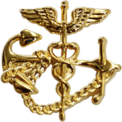

Commissioned Corps officers wear uniforms similar to those of the United States Navy and the United States Coast Guard with special Public Health Service insignia. Their service dress blues, summer whites, and service khakis have been modeled after the Navy's versions, and their operational dress uniform was modeled after the Coast Guard's.
In certain duty situations, a commissioned corps officer can be detailed to work with another uniformed service. For example, the NOAA Corps does not commission medical officers, so the commissioned corps details medical officers to support NOAA Corps officers as needed. The commissioned corps also details a number of officers to support the Coast Guard's medical needs. Because of this close relationship, if a commissioned corps officer is on assignment with the Coast Guard, the officer is required to wear the same service uniforms as commissioned Coast Guard officers, but still bearing PHS Commissioned Corps insignia to identify them. The commissioned corps officer is subject to the grooming standards of the service to which attached for uniform appearance.
The commissioned corps uses the same commissioned officer rank structure as the United States Navy and Coast Guard: from ensign to admiral (O-1 through O-10). Commissioned Corps officers are typically appointed via direct commission, and receive the same pay and benefits as other members of the uniformed services. They cannot hold a dual commission with another uniformed service but inter-service transfers are permitted via 10 U.S.C. § 716.
The commissioned corps is authorized to use warrant officer ranks W-1 to W-4 under the U.S. Code of law,[28] but does not currently use these ranks.
| Commissioned officer ranks, pay grades, titles and abbreviations of the United States Public Health Service Commissioned Corps | ||||||||||
|---|---|---|---|---|---|---|---|---|---|---|
| Ensign | Lieutenant (junior grade) |
Lieutenant | Lieutenant commander | Commander | Captain | |||||
| O-1 | O-2 | O-3 | O-4 | O-5 | O-6 | |||||
 |
 |
 |
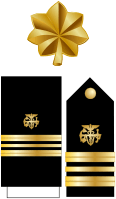 |
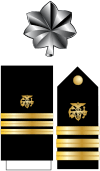 |
 | |||||
| Junior assistant | Assistant | Senior assistant | Full | Senior | Director | |||||
| ENS | LTJG | LT | LCDR | CDR | CAPT | |||||
| Rear admiral (lower half) | Rear admiral | Vice admiral | Admiral |
|---|---|---|---|
| O-7 | O-8 | O-9 | O-10 |
 |
 |
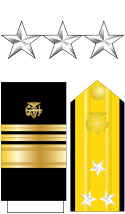 |
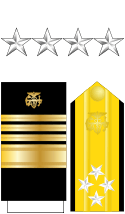 |
| Assistant surgeon general | Deputy surgeon general or Assistant surgeon general |
Surgeon general | Assistant Secretary for Health |
| RADM[29] | RADM | VADM | ADM |
Officer specialty rates
The members of the Commissioned Corps number over 6,000 officers in 11 professional categories:
- Dentist
- Dietitian
- Engineer
- Environmental health officers
- Health service officers
- Nurse
- Medical Officer
- Pharmacist
- Scientist
- Therapist (including physical, occupational, speech, respiratory)
- Veterinarian
The Health Services Officer (HSO) category comprises over 50 allied health specialties, including audiology, social workers, physician assistants, optometrists, statisticians, computer scientists, dental hygienists, medical records administrators, medical technologists and others.
Ready Reserve Corps
The Affordable Care Act (ACA), signed by President Obama on 23 March 2010, established the Ready Reserve Corps of the Public Health Service Commissioned Corps as the new surge capacity for the Commissioned Corps of the U.S. Public Health Service. The Ready Reserve Corps is intended to fulfill the need for additional commissioned personnel on short notice to assist Regular Corps personnel for both routine public health and emergency response missions during involuntary calls to active duty.[30]
All Reserve Corps officers who were serving on extended active duty on 23 March 2010 were converted to Regular Corps officers. The same legislation also abolished the Inactive Reserve Corps (IRC) on 23 March 2010, and consequently the commissions of the existing 10,000 commissioned corps IRC officers. The IRC consisted of inactive reservists voluntarily activating to provide over 3,000 active-duty days annually for routine and public health emergencies including during Hurricane Katrina and other emergency response missions and in providing surge capacity for numerous shortages in isolated and hardship underserved areas. Inactive reservists also played roles in the humanitarian shipboard training missions with other uniformed services.[30]
A Ready Reserve Corps Working Integrated Project Team was convened in April 2010 to propose policy concepts, a strategic framework, and a budget. It submitted its final report in June 2010. As of late 2010, the directives and policies to implement the Ready Reserve awaited Secretarial decisions.[30]
However, due to a technical error, the ACA failed to include statutory authority for pay and benefits, preventing the Ready Reserve Corps from being activated.[17] Efforts to pass legislation to correct these errors picked up in late 2019.[31] Funding was finally approved through the CARES Act, passed on March 18, 2020, in response to the COVID-19 pandemic.[18] The first officers were expected to be commissioned in the first half of 2021.[17]
March of the United States Public Health Service
Like most other U.S. uniformed services, the U.S. Public Health Service has a march and accompanying lyrics. Composed by retired U.S. Coast Guard Senior Chief Musician George King III in the late 1980s,[32] the lyrics are as follows:
The mission of our service is known the world around
In research and in treatment no equal can be found
In the silent war against disease no truce is ever seen
We serve on the land and the sea for humanity
The Public Health Service Team[33]
In popular culture
The commissioned corps was featured in the 1950 motion picture Panic in the Streets, in which Richard Widmark portrayed a Public Health Service physician tracking down a victim of pneumonic plague, an infectious disease that is one of three forms of plague, the other two being septicemic plague and bubonic plague.
See also
- Awards and decorations of the Public Health Service
- National Oceanic and Atmospheric Administration Commissioned Officer Corps
- Panic in the Streets (film)
References
- "PHS Commissioned Corps History". Department of Health and Human Services. Archived from the original on 20 October 2012. Retrieved 2 November 2017.
- "U.S. Public Health Service Commissioned Corps". Surgeongeneral.gov. Retrieved 1 May 2019.
- "Consultant's Report PHS/Coast Guard". epubs.democratprinting.com. Retrieved Apr 2, 2020.
- "Commissioned Corps Personnel Manual 29.9.1" (PDF). dcp.psc.gov. Retrieved 8 April 2019.
- "U.S. PHS Commissioned Officer Training Academy". dcp.psc.gov. Retrieved 8 April 2019.
- "Public Health Service (U.S.)". fotw.info. Retrieved 8 April 2019.
- other(s), Jarminator CMS 3.0 created by Dwayne Jarman, DVM, MPH - page ontent created by. "Ensemble". dcp.psc.gov. Retrieved 26 February 2018.
- "Home - Commissioned Officers Association". www.coausphs.org. Archived from the original on 28 November 2009. Retrieved 2 November 2017.
- "ADM Brett P. Giroir, M.D." HHS.gov. 15 February 2018.
- "U.S. Public Health Service Commissioned Corps". Surgeongeneral.gov. Retrieved 2 November 2017.
- "USPHS: About Us". www.usphs.gov. Archived from the original on 10 July 2007. Retrieved 2 November 2017.
- "42 U.S. Code § 204 - Commissioned Corps and Ready Reserve Corps". LII / Legal Information Institute. Retrieved 2 November 2017.
- "10 U.S. Code § 802 - Art. 2. Persons subject to this chapter". LII / Legal Information Institute. Retrieved 2 November 2017.
- "U.S. Public Health Service Commissioned Corps". U.S. Department of Health and Human Services. Archived from the original on 13 May 2008. Retrieved 24 June 2008.
- "USPHS: Career & Benefits". usphs.gov. Retrieved 2016-11-06.
- Landman, Keren (2019-06-24). "For America's Public Health Officers, Questions of Duty and Purpose". Undark Magazine. Retrieved 2020-07-11.
- Hamon, Caitlin (2020-04-14). "USPHS Ready Reserve Corps Becomes Law With the CARES Act". Military Officers Association of America. Retrieved 2020-07-10.
- Lawrence, Quil (April 15, 2020). "Public Health Service Poised To Create A Ready Reserve To Fight The Coronavirus". NPR. Retrieved April 16, 2020.
- Landman, Keren (2019-06-24). "For America's Public Health Officers, Questions of Duty and Purpose". Undark Magazine. Retrieved 2020-07-11.
- "Commisisoned Corps Deployments: Public Health Emergency Responders". Usphs.gov. September 19, 2014. Retrieved 2016-11-06.
- US Department of Health and Human Services. Emergency Response at Commissioned Corps Archived 2010-11-30 at the Wayback Machine
- "DCP.PSC.gov". Dcp.psc.gov. Archived from the original on 28 May 2010. Retrieved 2 November 2017.
- "USPHS: Error occurred!". www.usphs.gov. Archived from the original on 18 March 2013. Retrieved 2 November 2017.
- "FACT SHEET: Unaccompanied Children from Central America". 20 June 2014.
- "FACT SHEET: U.S. Response to the Ebola Epidemic in West Africa". Whitehouse.gov. 16 September 2014. Retrieved 2 November 2017.
- "Treating Those Treating Ebola in Liberia" article by Sheri Fink in The New York Times, November 5, 2014
- "DCP.PSC.gov" (PDF). Dcp.psc.gov. Archived from the original (PDF) on 10 November 2005. Retrieved 2 November 2017.
- 42 U.S.C. § 204 - Commissioned Corps and Ready Reserve Corps
42 U.S.C. § 207 - Grades, ranks, and titles of commissioned corps
42 U.S.C. § 209 - Appointment of personnel - "HHS Promotion Letter" (PDF). Archived from the original (PDF) on 20 January 2013. Retrieved 5 November 2012.
- "Ready Reserve Corps Update". US Public Health Service Commissioned Corps. Office of Reserve Affairs, Commissioned Corps E-Bulletin. 2 September 2010. Retrieved 14 January 2017.
- Maucione, Scott (2019-11-04). "Public Health Service gets congressional attention for ready reserve corps". Federal News Network. Retrieved 2020-07-10.
- "Images From the History of the Public Health Service: Supplementary Materials". www.nlm.nih.gov. Retrieved 26 February 2018.
- "Wayback Machine". 7 January 2013. Archived from the original on 7 January 2013. Retrieved 26 February 2018.
Further reading
- Fitzhugh, Mullan. Plagues and Politics: The Story of the United States Public Health Service. New York: Basic Books, 1989. ISBN 0-465-05779-9; ISBN 978-0-465-05779-5.
